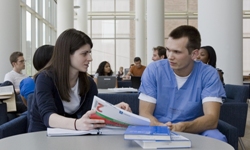A library designed with healing in mind
|
On an overcast weekday, students are hard at work in the Simmy and Harry Ginsburg Health Sciences Library --studying for medical credentialing exams, working collaboratively in the facility’s study rooms and tackling the rigors of research and medical education. The gleaming new facility, located in the new Medical School and Research Building at 3500 N. Broad Street, opened in June and has quickly become a central hub for studying and socializing among students across several of Temple’s health science disciplines. There they can do everything from check their email to access surgical texts from a previous century. |
 Medical students discuss their studies, surrounded by the floor-to-ceiling windows of the Ginsburg Health Sciences Library. |
|
The library is named in memory of the parents of Dr. Howard Ginsburg, a 1971 Medical School graduate who donated $2.5 million toward its construction. The Ginsburg library brings together services and resources formerly housed separately at the Kresge and South libraries, serving the schools of Medicine, Dentistry and Pharmacy, the College of Health Professions and the Temple Hospitals. (The School of Podiatric Medicine continues to be served by the Charles E. Krausz Library of Podiatric Medicine at the school’s Center City campus). According to Health Science Libraries director Mark-Allen Taylor, the new facility was designed specifically to meet the needs of those deeply engaged in the study of patient care. “Over the past 20 years, health sciences libraries have transformed from print-oriented collections of journals and books into electronic information centers,” said Taylor. “The Ginsburg Library provides online access to the tools necessary to meet the diverse needs of our community of caregivers.” The library has seating for more than 1,000 students and includes 30 study rooms, 10 collaborative learning “smart” rooms that students can use to work on various projects and two health science classrooms. There are also “quiet” study rooms that allow students the solitude needed to concentrate on anatomy textbooks or study for demanding exams, Taylor said. The building provides wireless network access and includes 75 public computer workstations for students to use. In addition, the library has 175 public computer workstations and a collection of rare medical textbooks, including journals such as MD Consult, Natural Standard, and The Journal of the American Medical Association. While the Ginsberg Health Sciences Library was built for service, Taylor says the building’s aesthetics were also given careful consideration. Just inside the first floor entrance from the Medical School and Research Building, there are several modern computer workstations and a spacious seating area where library patrons can overlook Broad Street through floor-to-ceiling windows. A sweeping spiral staircase leads to three floors filled with books, magazines and medical journals. The Ginsburg Health Sciences Library is open from 7 a.m. to 10 p.m. Monday through Thursday, 7 a.m. to 8 p.m. on Fridays, 9 a.m. to 5 p.m. on Saturdays and 1 p.m. to 10 p.m. on Sundays. |
|

Medical students discuss their studies, surrounded by the floor-to-ceiling windows of the Ginsburg Health Sciences Library.